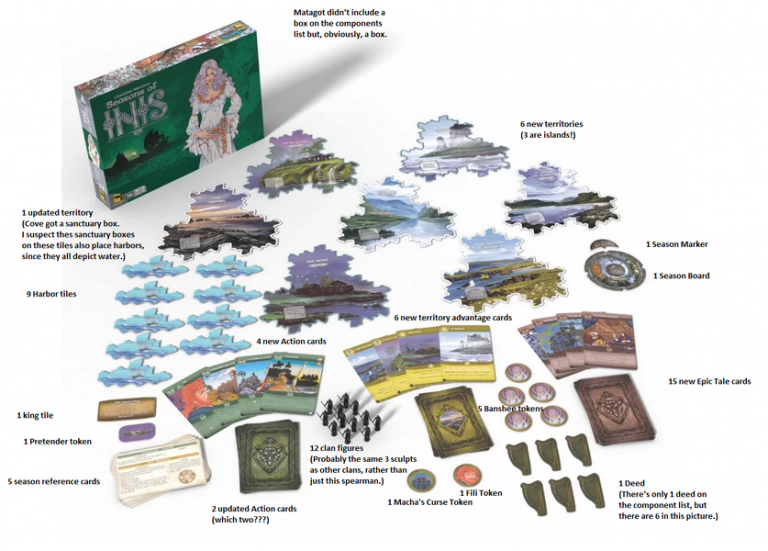Seasons of Inis Review

By MARK WILSON

Year Published: 2019
Players: 2-5
Playing Time: 90 Minutes
I’m a huge fan of Inis; it might be my favorite game ever. I actually think that fact mitigates my bias for this expansion, though, because it means I’ll be critical of “Seasons” if it worsens any of the best elements from the base game.
The expansion includes five modules. Like many recent expansions with modules, you can use any number of them, mixing and matching to your taste.
The Base Game of Inis, In Brief
Inis is a tactical game with military units in which players will attempt to get one or more of three possible victory conditions before their opponents. The board – a series of interlocking tiles representing regions – will be growing and become modified by cards, which are drafted each round by 2-4 players. Additionally, special ability cards (Epic Tale Cards) can be obtained, which are usually powerful but occasionally very situational. Each region also has a (usually minor) ability tied to it, that can be used when you control the region. There’s only 17 draftable cards (21 in the expansion), so you’ll learn the abilities quickly. But the ways in which they can be combined together, along with the special abilities, provide myriad ways to approach the game strategically. The game plays out in a thrust/counter-thrust manner between players as they vie for regions, resources, armies and victory conditions, while preventing others from doing the same. Players can form general long-term strategies, but this is balanced by more reactionary decisions that are required as a result of your opponents’ actions.
The game features direct conflict, and all but requires that players be willing to stick it to their neighbors on numerous occasions. Despite the strategy elements and some Euro-style mechanics, if you don’t enjoy direct conflict in your games, this is not for you.
The game shines due to how its elegant, easily taught rules and mechanics give way to a complex tactical puzzle that requires a lot of mental agility to navigate well. In this sense, it occupies the same thematic space in my mind as games like Troyes and Concordia, which have less direct conflict but also feature tight, tactical landscapes that emerge from a fairly basic rule set. I often describe Inis as “Concordia meets Cosmic Encounter,” merging the elegance and strategy of the former, with the wild, unpredictable swings and overt antagonism of the latter. Perhaps not the best description, but it works for me.
Module 1: 5 Players
This features new cards to accommodate a 5th player, and a couple modified cards that replace ones in the base game, that account for the possibility of a 5th player.
The jump from 4 to 5 players, or 5 to 6, can bring in entirely new groups to games, so this is excellent. For me, it definitely means I’ll be able to play it more often. I have no issue with the cards themselves, which integrate well with the base game’s cards. If you use nothing else from this expansion, this alone should give the game more flexibility.
The new cards, like those of the base game, offer interesting options for pairing them with others. In particular, we found some clever uses for the Fili card and Coalition card, the latter of which sneaks in occasional cooperative elements if one player has too commanding of a lead. We were able to negotiate some joint attacks on a stronger player using it, to the mutual benefit of at least a couple players.
Module 2: We Need a King
A couple of my plays didn’t end up needing this, but this module avoids long, drawn out ties that can last for multiple turns. A winner (or shared victory) will always be decided in the turn after the first where someone has a victory condition and pretender token.
I’d consider this a necessity at 5P, simply because the risk of an extended game is pretty high. Part of me really enjoyed that you could have games that lasted 30 minutes or 2 hours depending on how many rounds of tiebreakers you had to go through. It often adds drama and tension. Other times, though, it may just add tedium.
I wouldn’t use this in 2-3 player games, but would probably always use it in 4-5 player. A good, thoughtful addition.
Module 3: Seasons of Inis
There’s good and bad here, but I think the good outweighs the bad.
The module introduces a season mechanic, whereby each turn takes place in a season. There is an additional step in the Assembly Phase for each season, and in Summer and Winter, there’s an additional rule or option that you can do during the round.
The design intent here is clear. Most of these are to mitigate imbalances that can occur in card drafting or conflict. If you have very few region cards, or got decimated on the last turn in combat, you can still win in the base game (swings can happen very fast), but it’s an uphill battle. The options present in the Seasons module, such as the person with the least cards in their hand taking a particular action at the start of the round, are intended to aid that climb back to relevance. Another season ability allows you to discard an action card for a benefit. Anyone who’s ever gotten stuck on the game’s first turn or two with, say, two cards that start conflicts (which tend to be much less useful in the early game), will understand the appeal of this option.
The bad is that this is the first time I started to feel the weight of all the different options and things to remember. Inis works in large part because it’s wrapped in an elegant set of rules. It starts to drag a bit once we’re going back and forth saying, “Wait, now we have to do this before we proceed, and remember in this round you can do this as an action instead of using an action card. Ok, now in this next round you can do this different thing where…” Etc.
This probably makes it a tighter tactical puzzle that’s less punitive to those who end up on the wrong end of a draft or combat. But I do think there’s a bit of a trade-off where it loses some of the elegant charm of the base game. I’ll probably use it about half the time. YMMV.

Module 4: Sea Tiles (Harbors and Islands)
This introduces new region tiles that have harbors. Additionally, some of them are islands, which can only be accessed from harbor tiles and have some other rules surrounding them that make them harder to access and/or invade.
The potential for “rule bloat” that I mentioned in Module 3 exists here as well. I’m a bit more forgiving of this module, though, because it feels integrated into the game and its theme better than Module 3, which in comparison just feels like a new rules card that you have to reference every round. But back to Module 4, in one play, I created a series of sanctuaries and citadels on a relatively inaccessible island, and it truly felt secure in a way that the others didn’t. But I also couldn’t load up forces on it, or if I did, they couldn’t move around as easily. So it was sparsely manned. A nice strategic trade-off, allowing for the possibility of island hideouts, and the chance to create bottlenecks at the harbor(s) in order to limit access.
Overall, though, I expected these tiles to play more of a strategic factor in the game. Outside of the example above, they generally didn’t. So I don’t think it plays a huge role in the scheme of things, making it another fairly lightweight addition that won’t alter the overall feel of the game, but one that provides a bit more strategic nuance.
Module 5: Epic Tale Cards
15 new Epic Tale Cards, many of which bring new and interesting options into the mix. None will seem out of place with the base game, with a single exception that deals explicitly with island tiles. Minus that card, which will need to be removed if Module 4 isn’t being used, the rest can simply be inserted into the game at any player count and used with or without the other expansion modules.
Part of the fun of this game is getting Epic Tale cards, which may or may not be useful when you get them. But they’re always powerful in some situation, so it’s usually possible to shift your strategy to incorporate them. Without adding any new mechanics or complexity, these cards allow for more options, and thus new ways to be clever and confound your opponents.
The Feel of 5P
The biggest difference is that the 5p game gets a lot more complicated toward the end of the game, even compared to 4p. The number of possibilities for victory conditions and reversals is almost too much to hold in your head, even for experienced players. For some, this will be a good thing, because the last turn or two will be very unpredictable, with numerous possibilities for sneaking into a victory condition or other advantage. For others, this will overwhelm their strategic sensibilities and may make the game’s ending feel arbitrary.
For me, the saving grace is that you can always hunker down and focus on your own plans, rather than trying to counter everyone else’s. This may not ultimately be a winning strategy each time, but being myopic in this way can still allow for strategic decisions that will affect the board and other players. However, the most complicated final actions in my 5p games have inched toward “too much” in terms of things you’ll want to keep track of and try to account for. And since most players are developing their masterstroke to win the game, board states are constantly shifting during this time, much more so than the early and middle game. This chaos, to me, is an acceptable tradeoff to be able to add a 5th player, but I think the sweet spot between chaos and strategy in this game will remain at 3-4 players.
A Different Perspective
I spoke with my friends some after each play. More or less, their takes were positive. A couple opinions differed slightly from the above, though.
They really liked the expansion, but preferred Module 3 (Seasons) and weren’t huge fans of Module 4 (Islands/Harbors). The fact that it’s harder to move in and out of them is a possible strategic advantage, yes. But it also means they may simply be less important, and can more easily be ignored relative to the other, more dynamic tiles. Conversely, the Seasons module was for them a welcome addition of additional considerations; and I’ll admit that my take above is more about new players, to whom extra rules can be a burden. It never felt like a burden when I played with more experienced players who already knew the game. I don’t disagree with this opinion, though I’ll point out that it’s splitting hairs either way, since we all largely enjoyed the expansion and each module.
I think the takeaway is that Modules 3 and 4 have the potential to be the most polarizing, but in the case of my player group(s), this polarization was mild.
Artwork, Components & Price
Seasons of Inis is going for $50 currently. While the components are high-quality and the artwork is stunningly psychedelic (matching the base game), some may balk at the price tag. This is understandable. I wouldn’t say this expansion adds anything that’s absolutely necessary for an ideal Inis experience. If you don’t own the game and are curious, or it’s only an occasional pull at your table, you may be able to sit this one out. However, I think it’s an instant recommendation for those who play regularly and want to add something new to their game sessions, as well as groups that will benefit from the option of a 5th player. I fall into both of those groups, so purchasing was a no-brainer, but the same may not be true for all.
Seasons of Inis – Conclusions
Seasons of Inis works because most of the modules don’t get in the way of the fun the game already provides. Modules 1, 2 and 5 aren’t even expansion-style materials in the way we usually think of expansions. They could simply be inserted into the base game (minus one Epic Tale card), and an unsuspecting player could be taught the base game’s rules and never even know they didn’t originally come with the game. This is excellent.
I do think it loses something of its raw beauty in the addition of Modules 3 and 4. However, I recognize the balancing issues addressed in many of the Season rules, and I enjoy the new possibilities introduced by the sea tiles. So any loss is at least offset with some good additions. With new players, I will probably ditch one or both of Modules 3-4, to minimize the fiddly rules they’ll have to absorb. But I won’t hesitate to use all modules with experienced players.
If Inis ever comes out with another expansion, I’ll probably be more skeptical of it, though (but would still give it a chance, of course). I think this expansion gets it near to the limit, past which there would be diminishing returns on new mechanics, rules or even new cards. Inis, to me, isn’t a game that should be bogged down by multiple rule systems and exceptions within them. Thankfully, this expansion, even with all its modules, doesn’t quite reach that point of diminishing returns, so most or all of them should be welcome additions at any group’s game table.
…
For more content, or just to chat, find me on Twitter @BTDungeons, and if you enjoy my work, be sure to subscribe on Youtube!
Share
Recent Posts
Categories
- All (350)
- Announcements (4)
- Board Games (203)
- DMing (28)
- Game Design (16)
- Playing TTRPGs (22)
- Reviews (189)
- RPGs (142)
- Session Reports (91)
- Why Games Matter (9)